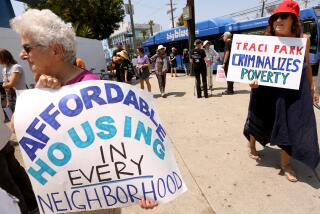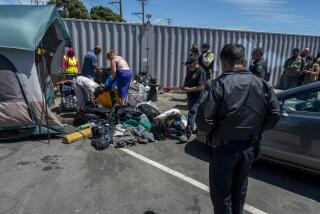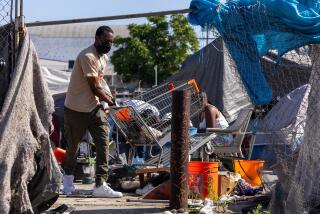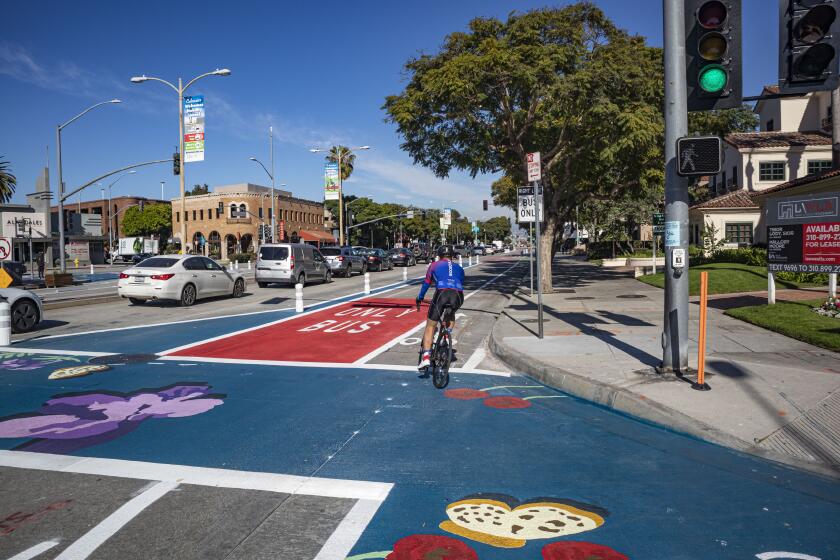To understand homelessness, listen to homeless people. Here’s what I learned

- Share via
When I began covering homelessness for the editorial board of the Los Angeles Times, a service provider told me something that has guided me to this day: “If you meet one homeless person, you’ve met one homeless person.”
So in addition to writing about homelessness policy and fights over housing, I wanted to hear the stories of people I encountered in my neighborhood and around the city.
I wrote about the well-kept man who lived in an RV outside my condo building with his fluffy white dog. I urged my concerned neighbors to help him get services, not get him towed. (One neighbor, a lawyer, was kind enough to do free legal work for him.) Eventually he drove off the street and never returned.
I met a woman sitting on a sidewalk outside a wine store on an industrial stretch of Cotner Avenue one early evening before the Fourth of July in 2019. Her name was Michelle, she was in her 50s, and she told me she just wanted a shelter bed for the night. Just released from a hospital, she was still wearing her hospital ID bracelet. She had no cellphone because an abusive ex-fiance had smashed it, she said. I called the nonprofit help hotline, 211, but the only thing the operators could find for her was a bed in the Antelope Valley — far from where we were on the Westside. After a while, Michelle slumped down and said she wanted to go back to the hospital.
The owner of the wine store and a staffer walked outside to see what was going on. I expected them to complain. Instead, they asked how they could help. I called an Uber to take her to the hospital. When the car arrived, the owner of the store pressed cash into the driver’s hand, asking him to take care of her. When I got back to work after the holiday, Michelle had called my office phone and left a message thanking me and saying she was OK. I never heard from her again.
The Los Angeles Homeless Services Authority now has a computerized system that tracks many shelter beds across the county in real time. It was rolled out to service providers this month and will be made available to the 211 hotline system in July.
Another time, I befriended a neatly dressed man who sat on a bench and politely panhandled outside a Whole Foods store in Santa Monica. James, in his mid-50s, had lost a job at a big retailer, and when his unemployment benefits ran out, he became homeless. James told me all he wanted was to rent a room in a house somewhere. He watched as luxury cars whizzed by and said surely someone had an empty room to offer him. Eventually a service provider found him a room in a six-bedroom apartment just west of USC. I visited once and brought him groceries. He shared the kitchen and dining area with the rest of the residents. At one point we heard a woman yelling at someone. “People here are crazy,” he told me with some chagrin. This was not the room of his dreams. I lost touch with him after that visit.
And then there was Joshua, a homeless man I have kept in touch with for years. I was the foreperson on a jury that found him guilty of a misdemeanor battery charge on a Metro train in 2019. I was curious about his life and why he had gotten into trouble. After the trial ended, I spent hours on the phone with him, sporadically, as he violated his probation, went back to jail then emerged again, usually with a new phone number. He found a trade school and took computer classes wanting to learn some kind of skill that would help him find a job. Eventually, he said, an instructor told him he was too unprepared to take the course and she couldn’t devote the time necessary to help him catch up.
These days, he exists on General Relief ($221 a month) and CalFresh food benefits delivered on an EBT card. He has spent nights sleeping on benches and trains and more recently on buses where he has found sympathetic drivers who chat with him and look the other way when he doesn’t pay the fare.
I repeatedly urged him to go to a shelter but he refused, saying they weren’t safe. I have listed the reasons why it was worth a try.
“I know you want better for me, Miss Hall,” he said once, hearing my exasperation. “It won’t always be like this.”
I want better for all of them — the unhoused people I met and those I never did. Don’t we all?
They don’t have to be heroic figures to deserve housing, any more than the people who already live in housing are heroic. I can’t guarantee that none of these folks ever napped on your lawn or, worse, went to the bathroom on it. But such cases only underscore that society should provide for every person’s basic needs to be met with dignity — eating, sleeping and other bodily functions. (And I have written editorials calling for more public toilets throughout the city.)
We should want better for all people who are this impoverished, who got waylaid possibly by mental illness or substance abuse — but above all by poverty. They are hamstrung by an economy in which housing is a commodity, an investment that skyrockets in value for no reason beyond that it is scarce and therefore increasingly valuable to its owner and decreasingly accessible to the vast number of Angelenos who can’t afford thousands of dollars a month in rent.
There are 75,000 unhoused people in the county of Los Angeles. (About 45,000 of those live in the city of L.A.) They all need permanent housing.
I once spoke to an assembly of students at a private school alongside Emily Martiniuk, a woman who is formerly homeless. She started by asking the students — in elementary grades and junior high — what they wanted to be when they grew up. Hands shot up as she ticked off various professions. “Now,” she said, “how many of you want to be homeless?”
Every journey into homelessness is different. The one thing every unhoused person shares is this: No one intended to be homeless. In Martiniuk’s case, crippling illness and depression caused her to lose her job and her family. “My life fell apart,” she told the students. But with medical care and help from social workers, she found permanent supportive housing, then another apartment subsidized by a housing voucher, and now speaks often to various groups and elected officials about her experiences.
I’ve spent years and thousands upon thousands of words arguing for measures that would increase funding for both the services and housing that homeless people need — the sort of services that helped Emily. I have scolded people for opposing homeless housing in their neighborhoods — even when they voted for the measures that would set aside funds for it — and embracing anti-camping ordinances as the way to get homeless people out of their neighborhoods.
Anti-camping ordinances don’t make people vanish. They simply get pushed to someone else’s neighborhood.
“Homeless housing” is a misnomer, really. It instantly eliminates the problem that it names, because as soon as people step into their apartments, they cease to be homeless. Those who suffered from mental illness or substance abuse — and crushing poverty — still will have those struggles, of course, but now they can face them with the knowledge of a secure place to sleep every night. That matters. Think of a problem you have faced — and how much harder it would have been if you had had no place to sleep, shower, store your possessions or use the bathroom.
In this last piece I write as a member of this honorable editorial board that has long cared about people and their fate in Los Angeles and beyond, I challenge you to care about providing homes to people who need them. I challenge you to welcome new affordable housing when it’s proposed in your community, because as an Angeleno witnessing this crisis, you know how many lives that housing could change — how many lives it could save. Hold Los Angeles politicians accountable not by insisting they keep these developments out of your neighborhood but by demanding they build more of them in all our neighborhoods.
Los Angeles cannot thrive if there is one community of people safely in homes and another forced onto the sidewalks.







